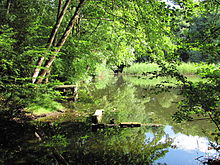Sievert clay pit
The Sievert clay pit is an approximately 10 hectare natural monument and geotope in Hamburg - Hummelsbüttel .
history
The clay pit was created in the course of the construction of a brick factory on today's Poppenbütteler Weg (Ring 3) and the junction of the Hummelsbütteler Weg. During the Second World War it was temporarily shut down, the bankruptcy of the brickworks at the end of the 1950s led to its final shutdown. The clay pit was declared a natural monument by the Senate Ordinance of February 11, 1986 in order to preserve its special geological significance and to protect the various animal and plant species.
geology
In the Sievert clay pit there is an important exposure of marine and limnic deposits from the Holstein warm period , the penultimate warm period before the present day. While the deposits of the Holstein Sea, the last sea that covered the area of Hamburg, are mostly covered by younger layers and can only be reached by drilling, they were compressed in the area of the clay pit by the glaciers of the last Ice Age and up to the Ground surface folded. The complete sequence of layers allows the Elster cold period (with Lauenburg clay ) to be traced through the freshwater deposits of the subsequent warm period up to the flooding by the Holstein Sea. With the help of micro-palaeontological investigations of these layers, insights into climate development and transgression in the Quaternary could be obtained.
The geotope, which is located on the southern excavation wall of the clay pit, was covered with a layer of soil after its investigation to prevent damage. The outcrop is therefore hidden from visitors to the clay pit.
Flora and fauna
A special flora developed on the calcareous raw soil of the former clay pit. Sun can be found on a small open space in the southern part of the pit several small sedge species, centaury ( Centaurium ) Nodding Dandelion ( Leontodon saxatilis ), Stone berry ( Rubus saxatilis ), Eyebright ( Euphrasia ) and Devil's ( Succisa prevention ). This open space is looked after by the Hamburg Botanical Association. In the northern part of the pit, which is a little deeper, there is a small pond. Here is one of two occurrences of the black-growing willow ( Salix myrsinifolia ) in Hamburg, also the broad-leaved sitter ( Epipactis helleborine ) occurs. Various types of dragonflies are at home at the pond, including the great shell-eye ( Erythromma najas ) and the great dragonfly ( Anax imperator ).
Access to the clay pit
The clay pit is accessed by a few unpaved, often damp paths that must not be left. The main entrance is on Eekbalken Street on the south side. There are further accesses on Poppenbütteler Weg on the north and from Hummelsbütteler Weg or the Gösselkoppel on the west side.
Individual evidence
- ↑ Sievert clay pit on minlex.de
- ^ Ordinance on the protection of the Sievert clay pit natural monument. 11 February 1986
- ↑ Sievert clay pit on www.botanikzauber.de
Web links
Coordinates: 53 ° 38 ′ 40 ″ N , 10 ° 3 ′ 23 ″ E


